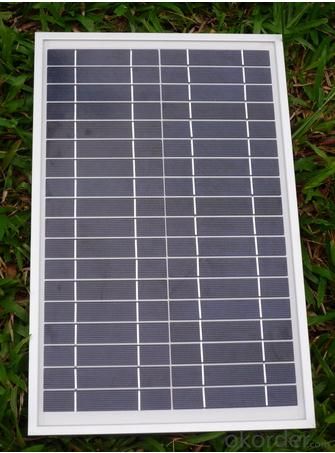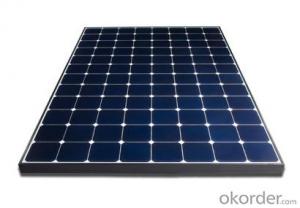120KW CNBM Monocrystalline Silicon Panel for Home Using
- Loading Port:
- Tianjin
- Payment Terms:
- TT OR LC
- Min Order Qty:
- 50 watt
- Supply Capability:
- 1000 watt/month
OKorder Service Pledge
OKorder Financial Service
You Might Also Like
Item specifice
120KW CNBM Monocrystalline Silicon Panel for Home Using
Production description
Off-the-grid homes are autonomous; they do not rely on municipal water supply, sewer, natural gas, electrical power grid, or similar utility services. A true off-grid house is able to operate completely independently of all traditional public utility services. The idea has been recently popularized by certain celebrities including Ed Begley, Jr.[1] who stars in Living with Ed[2] television show on the Home & The United Nations Development Programme in its 2000 World Energy Assessment found that the annual potential of solar energy was 1,575–49,387 exajoules (EJ). This is several times larger than the total world energy consumption, which was 559.8 EJ in 2012.
Electrical power can be generated on-site with renewable energy sources such as solar (particularly with photovoltaics), wind, micro hydro, geothermal; with agenerator or Micro combined heat and power with adequate fuel reserves. Such a system is called a stand-alone power system. In addition, it is possible to simply eliminate electric power such as in Old Order Amish and Old Order Mennonite communities.
Feature
1.High conversion efficiencies resulting in superior power output performance.
2.Outstanding power output even in low light or high temperature conditions
3.Optimized design for ease of soldering and lamination
Physical characteristic
1. Rigorous quality control meets the highest international standards.
2. High-transmissivity low-iron tempered glass, strong aluminium frame.
3. Using UV-resistant silicon.
4. IS09001/14001/CE/TUV/UL
Packaging
26pcs in one carton 6pallets in 20foot container 14pallets in 40 foot container.
- Q:What are the economic benefits of using solar energy systems?
- There are several economic benefits associated with using solar energy systems. Firstly, solar energy systems provide a long-term cost savings. Once the initial investment is made to install the solar panels, the cost of generating electricity from solar energy is significantly lower compared to traditional energy sources. The sun is a free and abundant source of energy, and once the system is in place, the operational costs are relatively low. This can lead to substantial savings on monthly electricity bills, especially for businesses or households with high energy consumption. Secondly, solar energy systems can provide a stable and predictable energy cost. With traditional energy sources, the prices of fossil fuels are subject to fluctuations due to factors such as geopolitical events, supply disruptions, or changes in market demand. In contrast, solar energy systems provide a more stable and predictable energy cost since sunlight is readily available and not influenced by external factors. This stability can benefit businesses in terms of budgeting and planning for the future. Furthermore, solar energy systems can also generate additional revenue streams. In some regions, excess solar energy generated can be fed back into the grid through net metering programs. This allows solar energy system owners to earn credits or receive compensation for the excess energy they produce. Additionally, some governments offer incentives and subsidies to encourage the adoption of solar energy systems. These can include tax credits, grants, or feed-in tariffs, which can further offset the initial investment cost and provide additional financial benefits. Another economic benefit of solar energy systems is the job creation potential. The solar industry has been growing rapidly in recent years, creating numerous job opportunities. From manufacturing and installation to maintenance and support services, the solar energy sector provides employment opportunities across various skill levels. This can contribute to local economic development and reduce unemployment rates. Lastly, the use of solar energy systems also has environmental and social benefits, which indirectly contribute to the economy. By reducing reliance on fossil fuels, solar energy helps to mitigate climate change and reduce air pollution, leading to improved public health and reduced healthcare costs. Additionally, utilizing solar energy promotes energy independence and reduces dependence on imported fossil fuels, thereby enhancing national security and reducing trade deficits. In conclusion, the economic benefits of using solar energy systems include long-term cost savings, stable energy costs, potential revenue generation, job creation, and positive environmental and social impacts. As the technology continues to advance and costs decrease, solar energy is becoming an increasingly attractive option for individuals, businesses, and governments seeking economic and sustainable energy solutions.
- Q:What is the role of inverters in a solar energy system?
- The role of inverters in a solar energy system is to convert the direct current (DC) electricity produced by solar panels into alternating current (AC) electricity that can be used to power common household appliances and be fed into the electrical grid.
- Q:Can solar energy systems be used for powering data centers?
- Yes, solar energy systems can be used for powering data centers. Solar panels can be installed on the rooftops or in open areas near the data center to capture sunlight and convert it into electricity. This renewable energy source can help reduce the carbon footprint of data centers and make them more sustainable. However, to ensure consistent power supply, data centers usually combine solar energy with other sources like grid electricity or energy storage systems.
- Q:Can solar energy be used for heating?
- Yes, solar energy can be used for heating. Solar thermal systems can capture the sun's energy and convert it into heat, which can be used for heating water, spaces, and even for industrial processes.
- Q:Can a solar energy system be installed on a floating platform?
- Yes, a solar energy system can be installed on a floating platform. Floating solar panels, also known as floating photovoltaic (FPV) systems, are becoming increasingly popular due to their ability to utilize large bodies of water, such as reservoirs, lakes, or oceans. These platforms can be anchored or tethered to the bottom, and the solar panels are mounted on them, allowing for the generation of renewable energy while conserving valuable land space. Floating solar energy systems have several advantages, including increased energy production due to the cooling effect of water, reduced evaporation from reservoirs, and the potential for dual-use, such as combining solar energy generation with aquaculture or water treatment.
- Q:Are solar energy systems suitable for commercial buildings?
- Yes, solar energy systems are suitable for commercial buildings. They offer numerous benefits such as reduced energy costs, increased energy efficiency, and a positive environmental impact. Additionally, solar panels can be easily installed on rooftops or as ground-mounted systems, making them a viable option for various types of commercial buildings.
- Q:Can a solar energy system be used in areas with high levels of pollution from industrial activities?
- Solar energy systems can still function in heavily polluted areas caused by industrial activities. Although pollution can affect the efficiency of solar panels, it does not render them completely useless. Even in polluted areas, solar panels are capable of generating electricity, albeit with a slight decrease in performance. It is important to consider the specific type and concentration of pollutants in the air, as this will determine the extent to which solar panel efficiency is impacted. Certain pollutants, like particulate matter or smog, can cast shade or reduce the amount of sunlight that reaches the solar panels, leading to a decrease in output. Additionally, pollutants can accumulate on the surface of the panels over time, resulting in lower efficiency. However, regular maintenance and cleaning of the solar panels can help mitigate the effects of pollution. By ensuring that the panels are kept clean and free from debris or pollutants, their efficiency can be maintained at optimal levels. Implementing cleaning schedules and utilizing advanced cleaning technologies can minimize any potential losses in electricity generation caused by pollution. Furthermore, advancements in solar technology and panel design have made them more resistant to various environmental factors, including pollution. Manufacturers are continuously improving the durability and resistance of solar panels to external influences, enabling them to perform better in polluted environments. In conclusion, solar energy systems can still be effectively utilized in areas with high pollution levels from industrial activities. Regular maintenance, cleaning, and technological advancements can help minimize any potential losses and ensure efficient electricity generation from solar panels.
- Q:Can solar energy systems be used for powering electric fences?
- Yes, solar energy systems can indeed be used for powering electric fences. Solar panels can generate electricity from sunlight, which can then be stored in batteries for later use. This stored energy can be utilized to power electric fences, providing a reliable and environmentally friendly source of power for livestock or perimeter security.
- Q:What is the efficiency of solar energy systems?
- The efficiency of solar energy systems refers to the amount of sunlight that is converted into usable energy. It is typically measured as a percentage of the total sunlight that strikes the surface of the solar panels and is converted into electricity. The efficiency of solar energy systems can vary depending on various factors such as the type of solar panel technology used, the quality of the panels, the location and orientation of the panels, and environmental conditions. On average, the efficiency of solar panels available in the market today ranges from around 15% to 20%. However, there are more advanced solar panel technologies, such as monocrystalline and polycrystalline panels, that can achieve higher efficiencies, up to 25%. It is worth noting that the efficiency of solar panels is constantly improving due to advancements in technology and research. Scientists and engineers are continuously working to develop more efficient solar cells and panel designs to harness more energy from the sun. Furthermore, it is important to consider that the efficiency of solar energy systems is not the only factor to consider when evaluating their overall performance. Other factors like the cost of installation, maintenance requirements, and the availability of sunlight in a particular area are also important considerations when determining the effectiveness and suitability of solar energy systems.
- Q:Can solar energy systems be used in areas with limited access to solar surge protection devices?
- Yes, solar energy systems can still be used in areas with limited access to solar surge protection devices. While surge protection devices are recommended to protect solar panels and equipment from sudden voltage spikes, their absence does not render the entire system unusable. Other protective measures, such as grounding the solar installation, using appropriate circuit breakers, and employing surge protection at the building's electrical panel can still help mitigate potential risks. Additionally, regular maintenance and monitoring of the system can help identify and address any potential issues.
1. Manufacturer Overview |
|
|---|---|
| Location | |
| Year Established | |
| Annual Output Value | |
| Main Markets | |
| Company Certifications | |
2. Manufacturer Certificates |
|
|---|---|
| a) Certification Name | |
| Range | |
| Reference | |
| Validity Period | |
3. Manufacturer Capability |
|
|---|---|
| a)Trade Capacity | |
| Nearest Port | |
| Export Percentage | |
| No.of Employees in Trade Department | |
| Language Spoken: | |
| b)Factory Information | |
| Factory Size: | |
| No. of Production Lines | |
| Contract Manufacturing | |
| Product Price Range | |
Send your message to us
120KW CNBM Monocrystalline Silicon Panel for Home Using
- Loading Port:
- Tianjin
- Payment Terms:
- TT OR LC
- Min Order Qty:
- 50 watt
- Supply Capability:
- 1000 watt/month
OKorder Service Pledge
OKorder Financial Service
Similar products
New products
Hot products
Related keywords





























